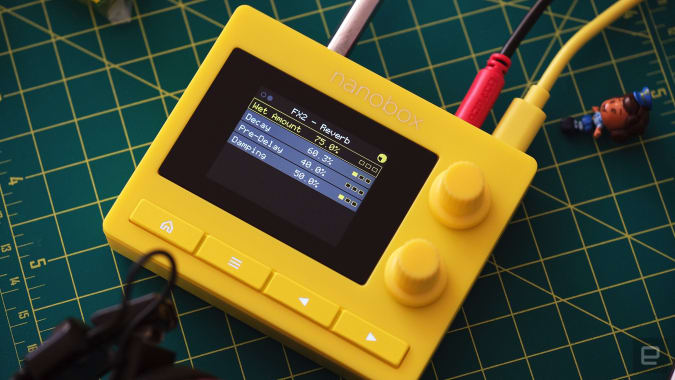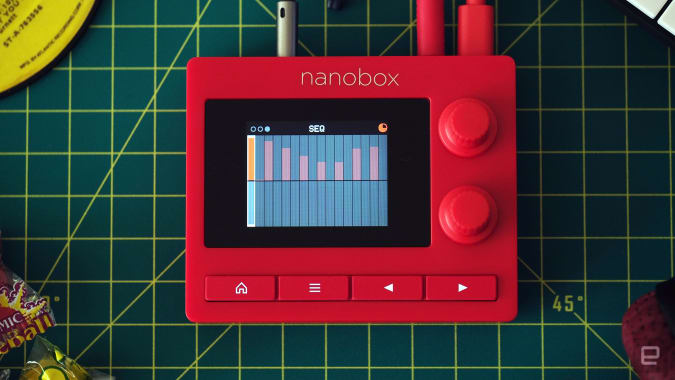Lemondrop and Fireball review | Engadget
Image Credit: Terrence O'Brien / Engadget
Those macros can also be controlled using the touchscreen when it's in X/Y mode. Frankly, for something of this size, it’s basically the ideal way to interact with it. It’s immensely satisfying and easy to dramatically alter the sound of a patch simply by sliding your finger around the screen. When you’re in this mode the two knobs change the default point of the macros on the X/Y axis, so you can push it all the way to the bottom left of the screen, then tap the top right to create intense rhythmic pulses.
Pairing X/Y mode with an external MIDI controller gives you a surprisingly hands-on instrument. But, if you want to just play the devices themselves, you can. There’s a grid mode where you can tap out notes, and you can lock it to a scale to avoid making too many mistakes. Now, this isn’t exactly the easiest or most enjoyable way to play a synth, but it gets the job done. I’ve found it particularly useful for sampling notes and chords from the Fireball to my PO-33, or playing a drone on the Lemondrop (using the hold function) and using the X/Y to create evolving soundscapes.
The biggest knock against the Nanoboxes on the hardware front is the lack of battery power. Yes, USB batteries are nearly ubiquitous at this point, but it would be great to have the option of powering them with a couple of AAs. Between audio, MIDI and power, there’s an awful lot of cables coming out of the back of what is ostensibly something portable.
Software

Terrence O'Brien / Engadget
The two instruments share a lot in common under the hood as well. The UI is largely the same. They both have a pair of primary sound sources (two wavetable oscillators or two granulators), plus a third simple oscillator that can help thicken up a sound using saw, square, triangle or sine waves. They both have two envelopes, two LFOs and a modulation sequencer, plus two morphable filters (low pass, high pass, bandpass and notch) that can be routed in series or parallel. Lastly, they both have two effects slots, one for modulation (chorus, flanger / distortion, or phaser) and one for time (delay or reverb).
This means basically that every pro for the Lemondrop also applies to the Fireball (with one notable exception we’ll get to later), and every con for the Fireball also applies to the Lemondrop. For example, while the effects are solid, and having pingpong delay on board is a welcome touch, they’re not going to win any awards. I will say that the reverb is truly excellent, though. Cranking it to full gets you some lovely, slightly unnatural ambience. And, when combined with the distortion, it results in some gorgeous digital howls that are perfect for scoring the surrealist ending of an arthouse horror film.
The two envelopes and LFOs are extremely useful for shaping your sound. They can create motion or manipulate the oscillators to constantly shift the tone. And many parameters can have up to three modulation sources for serious unpredictability. But not everything can be a modulation destination. Oddly, too, some destinations can only use a specific set of modulation sources. So if you wanted to use the LFO 2 to modulate the rate of the flanger – tough.

Terrence O'Brien / Engadget
Similarly, the modulation sequencer is great for creating complex patterns, but it can only be used with a few different destinations. Thankfully, one of those destinations is oscillator pitch, and it can be quantized. That gives you access to a rudimentary sequencer, or makeshift arpeggiator without the need for additional gear. You can even use the sequencer to control just a single oscillator, giving you a note pattern played against a bass note.
I also can’t help but wish there was a centralized UI for controlling the modulation routing. Right now, if you want to see what macro X is controlling you have to dig through all the parameters one by one and go into the modulation submenu for it, and just kinda keep track as you go.
In general, designing patches requires a decent amount of menu diving. That’s not surprising given the size of the instruments. And credit to 1010music for designing an interface that never feels too cumbersome. That said, I do occasionally find myself forgetting where particular options are located.
Sound

